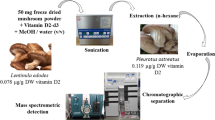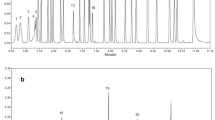Abstract
It has previously been shown that irradiation with UV light increases the vitamin D content of certain mushroom species, but the effect on other nutrients is unknown, and is difficult to assess due to the complexity of the sample matrix. Here, an offline reversed phase × reversed phase two-dimensional liquid chromatography methodology was developed and applied to Agaricus bisporus mushrooms in order to demonstrate the potential of the technique and assess the effect of UV irradiation on the mushroom’s metabolic profile. The method allowed the detection of 158 peaks in a single analytical run. A total of 51 compounds including sugars, amino acids, organic and fatty acids and phenolic compounds were identified using certified reference standards. After irradiation of the mushrooms with UV for 30 s the number of peaks detected decreased from 158 to 150; 47 compounds increased in concentration while 72 substances decreased. This is the first time that two-dimensional liquid chromatography has been carried out for the metabolomic analysis of mushrooms. The data provide an overview of the gain/loss of nutritional value of the mushrooms following UV irradiation and demonstrate that the increased peak capacity and separation space of two-dimensional liquid chromatography has great potential in metabolomics.




Similar content being viewed by others
References
Albert, P. J., Proal, A. D., & Marshall, T. G. (2009). Vitamin D: The alternative hypothesis. Autoimmunity Reviews, 8, 639–644.
Barros, L., Cruz, T., Baptista, P., Estevinho, L. M., & Ferreira, I. C. F. R. (2008). Wild and commercial mushrooms as source of nutrients and nutraceuticals. Food and Chemical Toxicology, 46, 2742–2747.
Bauer Petrovska, B. (2001). Protein fraction in edible Macedonian mushrooms. European Food Research and Technology, 212, 469–472.
Belaz, K. R. A., Pereira-Filho, E. R., & Oliveira, R. V. (2013). Development of achiral and chiral 2D HPLC methods for analysis of albendazole metabolites in microsomal fractions using multivariate analysis for the in vitro metabolism. Journal of Chromatography B, 932, 26–33.
Calvo, M. S., & Whiting, S. J. (2013). Survey of current vitamin D food fortification practices in the United States and Canada. The Journal of Steroid Biochemistry and Molecular Biology, 136, 211–213.
Carvalho, L. M., Carvalho, F., de Lourdes Bastos, M., Baptista, P., Moreira, N., et al. (2014). Non-targeted and targeted analysis of wild toxic and edible mushrooms using gas chromatography–ion trap mass spectrometry. Talanta, 118, 292–303.
Cho, I. H., Kim, Y.-S., & Choi, H.-K. (2007). Metabolomic discrimination of different grades of pine-mushroom (Tricholoma matsutake Sing.) using 1H NMR spectrometry and multivariate data analysis. Journal of Pharmaceutical and Biomedical Analysis, 43, 900–904.
Cho, I. H., Namgung, H. J., Choi, H. K., & Kim, Y. S. (2008). Volatiles and key odorants in the pileus and stipe of pine-mushroom (Tricholoma matsutake Sing.). Food Chemistry, 106, 71–76.
Davis, J. M., & Giddings, J. C. (1983). Statistical theory of component overlap in multicomponent chromatograms. Analytical Chemistry, 55, 418–424.
DeLuca, H. F. (1988). The vitamin D story: A collaborative effort of basic science and clinical medicine. The Journal of the Federation of American Societies for Experimental Biology, 2, 224–236.
Fairchild, J. N., Horvath, K., Gooding, J. R., Campagna, S. R., & Guiochon, G. (2010). Two-dimensional liquid chromatography/mass spectrometry/mass spectrometry separation of water-soluble metabolites. Journal of Chromatography A, 1217, 8161–8166.
Holland, B. J., Francis, P. S., Li, B., Tsuzuki, T., Adcock, J. L., et al. (2012). Chemiluminescence detection of cannabinoids and related compounds with acidic potassium permanganate. Drug testing and analysis, 4, 675–679.
Jasinghe, V. J., & Perera, C. O. (2006). Ultraviolet irradiation: The generator of vitamin D2 in edible mushrooms. Food Chemistry, 95, 638–643.
Jones, O. A. H., & Hügel, H. M. (2013). Bridging the Gap: Basic metabolomics methods for natural product chemistry. In U. D. Roessner & A. Dias (Eds.), Metabolomics tools for natural product discovery. Methods in molecular biology (Vol. 1055, pp. 245–266). New York: Humana Press.
Kiffe, M., Graf, D., & Trunzer, M. (2007). Two-dimensional liquid chromatography/mass spectrometry set-up for structural elucidation of metabolites in complex biological matrices. Rapid Communications in Mass Spectrometry, 21, 961–970.
Koyyalamudi, S. R., Jeong, S.-C., Song, C.-H., Cho, K. Y., & Pang, G. (2009). Vitamin D2 formation and bioavailability from Agaricus bisporus button mushrooms treated with ultraviolet irradiation. Journal of Agricultural and Food Chemistry, 57, 3351–3355.
Le Belle, J. E., Harris, N. G., Williams, S. R., & Bhakoo, K. K. (2002). A comparison of cell and tissue extraction techniques using high-resolution 1H-NMR spectroscopy. NMR in Biomedicine, 15, 37–44.
Lips, P. (2007). Vitamin D status and nutrition in Europe and Asia. The Journal of Steroid Biochemistry and Molecular Biology, 103, 620–625.
Lips, P. (2010). Worldwide status of vitamin D nutrition. The Journal of Steroid Biochemistry and Molecular Biology, 121, 297–300.
Mattila, P., Suonpää, K., & Piironen, V. (2000). Functional properties of edible mushrooms. Nutrition, 16, 694–696.
Mau, J.-L., Chen, P.-R., & Yang, J.-H. (1998). Ultraviolet irradiation increased vitamin D2 content in edible mushrooms. Journal of Agricultural and Food Chemistry, 46, 5269–5272.
McCombie, A.-M., Mason, R. S., & Damian, D. L. (2009). Vitamin D deficiency in Sydney skin cancer patients. The Medical Journal of Australia, 190, 102.
Miles, P. G., & Chang, S.-T. (2004). Mushrooms: cultivation, nutritional value, medicinal effect, and environmental impact. Boca Raton: CRC Press.
Munns, C. F., Simm, P. J., Rodda, C. P., Garnett, S. P., Zacharin, M. R., et al. (2012). Incidence of vitamin D deficiency rickets among Australian children: an Australian Paediatric Surveillance Unit study. The Medical Journal of Australia, 196, 466–468.
O’Gorman, A., Barry-Ryan, C., & Frias, J. (2012). Evaluation and identification of markers of damage in mushrooms (Agaricus bisporus) postharvest using a GC/MS metabolic profiling approach. Metabolomics, 8(1), 120–132.
Phillips, K. M., Ruggio, D. M., Horst, R. L., Minor, B., Simon, R. R., et al. (2011). Vitamin D and sterol composition of 10 types of mushrooms from retail suppliers in the United States. Journal of Agricultural and Food Chemistry, 59, 7841–7853.
Sambrook, P. N., Cameron, I. D., Cumming, R. G., Lord, S. R., Schwarz, J. M., et al. (2002). Vitamin D deficiency is common in frail institutionalised older people in northern Sydney. The Medical Journal of Australia, 176, 560.
Sergeev, I. N. (2005). Calcium signaling in cancer and vitamin D. The Journal of Steroid Biochemistry and Molecular Biology, 97, 145–151.
Stevenson, P. G., Mnatsakanyan, M., Guiochon, G., & Shalliker, R. A. (2010). Peak picking and the assessment of separation performance in two-dimensional high performance liquid chromatography. Analyst, 135, 1541–1550.
Teichmann, A., Dutta, P. C., Staffas, A., & Jägerstad, M. (2007). Sterol and vitamin D2 concentrations in cultivated and wild grown mushrooms: Effects of UV irradiation. LWT Food Science and Technology, 40, 815–822.
Acknowledgments
One of the authors (JP) thanks RMIT University and the CSIRO for the award of a PhD scholarship awarded under the Food Futures Flagship.
Conflict of interest
The authors declare that the research was conducted in the absence of any commercial or financial relationships that could be construed as a potential conflict of interest.
Compliance with ethical requirements
This article does not contain any studies with human or animal subjects.
Author information
Authors and Affiliations
Corresponding author
Rights and permissions
About this article
Cite this article
Pandohee, J., Stevenson, P.G., Conlan, X.A. et al. Off-line two-dimensional liquid chromatography for metabolomics: an example using Agaricus bisporus mushrooms exposed to UV irradiation. Metabolomics 11, 939–951 (2015). https://doi.org/10.1007/s11306-014-0749-4
Received:
Accepted:
Published:
Issue Date:
DOI: https://doi.org/10.1007/s11306-014-0749-4




